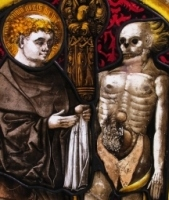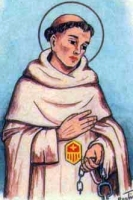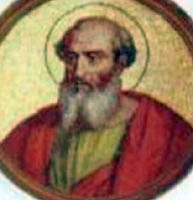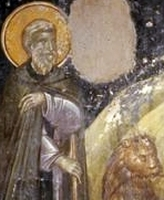Saint Colette
புனிதர் கொலெட்
மடாதிபதி, நிறுவனர்:
பிறப்பு: ஜனவரி 13, 1381
கோர்பீ, அமியேன்ஸ், பர்கண்டி
இறப்பு: மார்ச் 6, 1447 (வயது 66)
கெண்ட், ஃப்லேண்டர்ஸ், பர்கண்டி
ஏற்கும் சமயம்:
ரோமன் கத்தோலிக்க திருச்சபை
ஃபிரான்சிஸ்கன் சபை, கொலேட்டின் புவர் க்ளேர் சபை
முக்திபேறு பட்டம்: ஜனவரி 23, 1740
திருத்தந்தை பன்னிரெண்டாம் கிளெமென்ட்
புனிதர் பட்டம்: மே 24, 1807
திருத்தந்தை ஏழாம் பயஸ்
முக்கிய திருத்தலம்:
பெத்லேஹெம் துறவுமடம், கென்ட், பெல்ஜியம்
நினைவுத் திருநாள்: மார்ச் 6
பாதுகாவல்:
குழந்தைப் பேறு வேண்டும் பெண்கள்
தாயாகக் காத்திருக்கும் பெண்கள்
நோய்வாய்ப்பட்ட குழந்தைகள்
புனிதர் கொலெட் (St. Colette of Corbie), ஒரு ஃபிரெஞ்ச் துறவுமடாதிபதியும், "புனிதர் கிளாரா சபையின்" (Order of Saint Clare) சீர்திருத்தப்பட்ட கிளையான "கொலேட்டின் எளிய கிளாரா" (Colettine Poor Clares) எனும் சபை நிறுவனரும் ஆவார். எண்ணற்ற அதிசயச் சம்பவங்கள் இவர் வாழ்க்கையின் நிகழ்ந்ததால், இவர் "குழந்தைப் பேறு வேண்டும் பெண்கள்", "தாயாகக் காத்திருக்கும் பெண்கள்", மற்றும் "நோய்வாய்ப்பட்ட குழந்தைகள்" ஆகியோரின் பாதுகாவலராக வணங்கப்படுகிறார். ரோமன் கத்தோலிக்க திருச்சபை இவரை புனிதராக அருட்பொழிவு செய்தது.
"நிகோல் போல்லெட்" (Nicole Boellet) எனும் இயற்பெயர் கொண்ட புனிதர் கொலெட், ஃபிரான்ஸ் நாட்டின் "பிகார்டி" (Picardy) பிராந்தியத்திலுள்ள "கோர்பீ" (Corbie) எனும் கிராமத்தில் கி.பி. 1381ம் ஆண்டு, ஜனவரி மாதம், 13ம் நாள், பிறந்தார். "கோர்பீ" கிராமத்திலுள்ள "பெனடிக்டைன் துறவு மடத்தின் (Benedictine Abbey of Corbie) ஏழைத் தச்சரான "ராபர்ட் போல்லெட்" (Robert Boellet) இவரது தந்தை ஆவார். இவரது தாயாரின் பெயர் "மார்கரெட் மோயோன்" (Marguerite Moyon) ஆகும்.
இவரது பெற்றோர் முதிர் வயதுவரை குழந்தைப் பாக்கியமின்றி இருந்ததாகவும், பின்னர் அவர்கள் "புனிதர் நிக்கோலசை" (Saint Nicholas) நோக்கி குழந்தைப்பேறு வேண்டி ஜெபித்ததால் அவர்களது அறுபதாவது வயதில் பிறந்த பெண் குழந்தைக்கு புனிதர் நிக்கோலசுக்கு நன்றி கூறுவதற்காக பிறந்த குழந்தைக்கு "நிக்கோல்" என்று பெயரிட்டதாகவும், அவரது பெற்றோர் அவரை அன்புடன் "நிகொல்லெட்" (Nicolette) என அழைத்ததாகவும் பின்னர் அந்த பெயராலேயே அவர் அறியப்பட்டதாகவும் அவரது சமகால வாழ்க்கை வரலாற்றாசிரியர்கள் கூறுகின்றனர்.
நிகொல்லெட்டின் பதினெட்டு வயதில் அவரது பெற்றோர் மரித்தனர். பின்னர் அவர் "பெகுய்ன்ஸ்" (Beguines) எனப்படும் சகோதரிகளின் (மத வார்த்தைப்பாடுகள் பெறாத) சபையில் இணைந்தார். அச்சபையோரின் இணையற்ற வாழ்க்கை முறையால் ஈர்க்கப்பட்டார். கி.பி. 1402ம் ஆண்டு, புனிதர் ஃபிரான்ஸிசின் மூன்றாம் நிலை சபையில் (Third Order of St. Francis) இணைந்தார். கோர்பீ தேவாலயத்தின் அருகேயுள்ள கோர்பீ மடாதிபதியின் ஆலோசனையின் பேரில் அவர் ஒரு துறவியாக மாறினார்.
நான்கு வருட துறவுப் பணியின் பின்னர், அவர் கண்ட பல்வேறு கனவுகள் மற்றும் திருக்காட்சிகளின் அடிப்படையில், "ஃபிரான்சிஸ்கன் இரண்டாம் நிலை" (Franciscan Second Order) சபையை சீரமைத்து, அதன் முழுமையான எளிமை மற்றும் தாழ்ச்சிக்கே திருப்பித் தர தாம் அழைக்கப்படுவதாக நம்பினார். அதன்படியே செய்தார்.
கி.பி. 1406 முதல் 1412ம் ஆண்டு வரையான காலகட்டத்தில் அவர் பல்வேறு துறவு மடங்களை நிறுவினார். தமது வாழ்நாள் முழுதும் அவர் 18 துறவு மடங்களை நிறுவினார். துறவு மட காரியங்களுக்காக அவர் பயணித்த ஊர்களுக்கு காலணிகள் அணியாது வெறும் கால்களுடனேயே பயணித்தார். நித்திய விரதம், எளிமை மற்றும் தாழ்ச்சியின் அடையாளமாக திகழ்ந்தார்.
கி.பி. 1447ம் ஆண்டு, மார்ச் மாதம், ஆறாம் நாளன்று, "கென்ட்" (Ghent) என்னுமிடத்தில் கொலெட் மரித்தார்.
Also known as
• Coleta
• Colette Boylet
• Collette of Corbie
• Nicholette Boilet
• Nicolette
Additional Memorial
7 February (Franciscans, Capuchins)
Profile
Carpenter's daughter whose parents were near 60 at her birth. Colette was orphaned at age 17, and left in the care of a Benedictine abbot. Her guardian wanted her to marry, but Colette was drawn to religious life. She initially tried to join the Beguines and Benedictines, but failed in her vocation. Franciscan tertiary. Hermitess. On 17 September 1402, at age 21, she became an anchoress - walled into a cell whose only opening was a grilled window into a church.
She had visions in which Saint Francis of Assisi ordered her to restore the Rule of Saint Clare to its original severity. When she hesitated, she was struck blind for three days and mute for three more; she saw this as a sign to take action.
Colette tried to follow her mission by explaining it, but had no success. Realizing she needed more authority behind her words, she walked to Nice, France, barefoot and clothed in a habit of patches, to meet Peter de Luna, acknowledged by the French as the schismatic Pope Benedict XIII. He professed her a Poor Clare, and was so impressed that he made her superioress of all convents of Minoresses that she might reform or found, and a missioner to Franciscan friars and tertiaries.
She travelled from convent to convent, meeting opposition, abuse, slander, and was even accused of sorcery. Eventually she made some progress, especially in Savoy, where her reform gained sympathizers and recruits. This reform passed to Burgundy in France, Flanders in Belgium and Spain.
Colette helped Saint Vincent Ferrer heal the papal schism. She founded seventeen convents; one branch of the Poor Clares is still known as the Colettines.
She was known for a deep devotion to Christ's Passion with an appreciation and care for animals. Colette fasted every Friday, meditating on the Passion. After receiving Holy Communion, she would fall into ecstasies for hours. She foretold the date of her own death.
Born
13 January 1381 at Corbie, Picardy, France as Nicolette Boilet, named in honor of Saint Nicholas of Myra
Died
• 6 March 1447 at Ghent, Belgium of natural causes
• relics at the Monastère Sainte-Claire, Poligny, France
Canonized
24 May 1807 by Pope Pius VII
Patronage
• against eye disorders
• against fever
• against headaches
• against infertility
• against the death of parents
• craftsmen
• Poor Clares
• servants
• Corbie, France
• Ghent, Belgium
Saint Chrodegang of Metz
புனித_குரோத்கேங்க் (714-776)
மார்ச் 06
இவர் (#StChrodegangOfMetz) பெல்ஜியத்தைச் சார்ந்தவர். இவரது பெற்றோர் சிக்ரம், லாண்ட்ராதா என்பவராவர்.
நல்லதொரு கல்வியைப் பெற்று, பல முக்கியப் பொறுப்புகளை வகித்த இவர், நோன்பிற்கும் இறைவேண்டலுக்கும் ஒறுத்தல் முயற்சிகளுக்கும் மிகுந்த முக்கியத்துவம் கொடுத்து வந்தார். இவர் ஏழைகளிடம் மிகுந்த கரிசனை கொண்டிருந்தார் என்பதும் குறிப்பிடத்தக்கது.
இந்நிலையில் இவர் 748 ஆம் ஆண்டு மெட்ஜ் நகரின் ஆயராக உயர்த்தப்பட்டார். இவர் ஆயராக உயர்த்தப்பட்ட பிறகு மறைமாவடத்தைச் சிறந்த விதமாய் வழிநடத்தினார். அருள்பணியாளர்களின் பணிவாழ்விலும் மறுமலர்ச்சியை ஏற்படுத்தினார்.
இவர் திருத்தந்தையையின் பிரதிநிதியாகவும் இருந்தார். இதனால் இவர் திருஅவைக்கு அச்சுறுத்தலாக இருந்த தப்பறைக் கொள்கைகளைக் கடுமையாக எதிர்த்தார்.
இவ்வாறு திருஅவையைப் பலவிதங்களில் கட்டிக் காத்த இவர் 776 ஆம் ஆண்டு இறையடி சேர்ந்தார்.
Also known as
Chrodegand, Chrodegangus, Chrodegrang, Chrodegrangus, Chrodogand, Chrodogandus, Chrotgang, Chrotgangus, Droctegangus, Godegrand, Godegrandus, Grodegandus, Grodegangus, Grodogangus, Gundigran, Krodegandus, Ratgang, Rodigang, Rudigangus, Ruggandus, Ruodgangus, Ruotgangus, Rutgangus, Sirigang and Sirigangus
Additional Memorial
3 October (Augustinians)
Profile
Son of Sigram and Landrada; related to Pepin the Short; brother of Saint Opportuna of Montreuil. Educated at Saint Trond abbey. Secretary to Charles Martel. Chancellor of France. Even while holding such positions, he went about in hair shirts, fasting, praying, and supporting the poor. Bishop of Metz, France in 742 even though he was still a layman. Chief minister to Pepin the Short. Ambassador to the Vatican. Mayor of the Palace. Involved in the coronation of Pepin as King of the Franks, the first Carolingian king. Defended Rome and the papacy against the Lombards. Worked to reform the Frankish Church, including educating the clergy, and encouraging them to live in communities based largely on the Benedictine Rule. Founded and restored churches and monasteries. Introduced the Roman liturgy and Gregorian Chant to his see, from which they spread to other parts of Europe. Participated in several councils.
Born
c.714 at Hesbaye, Brabant, near Liege, Belgium
Died
• 6 March 776 at Metz, France
• relics, in the Benedictine Abbey of Saint-Symphorien, were destroyed during the French Revolution
Saint Fridolin
Also known as
• Apostle of the Upper Rhine
• Fridolin Vandreren of Säckingen
• Irish Wanderer
Profile
Born to the Irish nobility. Evangelist. Benedictine monk at Luxeuil Abbey and at Poitiers, France. Received a vision of Saint Hilary of Poitiers in which he was shown the location of Hilary's relics, which had been lost during a Vandal invations. Fridolin found them, and built a chapel to house them. He built churches in Alsace, in Switzerland, and in Burgundy. Missionary among the Alamanni in the Upper Rhine; many thought he was a roaming cattle thief, and chased him away. He founded the monastery in Säckingen, Baden (part of modern Germany, and served as its abbot. On the date of his feast, the houses of Säckingen are decorated with the flags of Germany, Switzerland, and Ireland.
Born
Irish
Died
• c.540 at Säckingen, Germany of natural causes
• buried in Säckingen
Patronage
• for good weather
• Alsace, France
• Glarus, Switzerland
• Säckingen, Germany
• Strasbourg, France
Representation
• abbot leading a skeleton by the hand
• pilgrim with a staff and book
Blessed Sylvester of Assisi
அசிசியின் புனிதர் சில்வெஸ்டர்
கடவுளின் ஊழியர்/ ஃபிரான்சிஸ்கன் சபையின் முதல் குரு:
பிறப்பு: கி.பி. 1175
அசிசி
இறப்பு: மார்ச் 6, 1240
ஏற்கும் சமயம்:
ரோமன் கத்தோலிக்க திருச்சபை
நினைவுத் திருநாள்: மார்ச் 6
கடவுளின் ஊழியர் (The Servant of God) என்றழைக்கப்படும் அசிசியின் புனிதர் சில்வெஸ்டர், பன்னிரெண்டாம் நூற்றாண்டின் இறுதியில், பெருஜியா மாகாணத்திலுள்ள (Province of Perugia) ஊம்ப்ரியா (Umbria region) பிராந்தியத்தின் அசிசி (Assisi) நகரில் பிறந்தவர் ஆவார்.
சில்வெஸ்டர், நகரின் பிரபுக்கள் குடும்பங்களின் சந்ததியைச் சேர்ந்தவர் ஆவார். புனிதர் கிளாராவின் (St. Clare of Assisi) தந்தையான “ஃபேவரோன் டி மொநேல்டோ’வின்” (Favarone di Monaldo) சகோதரரான, “ரோசன் டி மொநேல்டோ” (Rosone di Monaldo), சில்வெஸ்டரின் தந்தையார் ஆவார்.
புனிதர் ஃ பிரான்சிஸின் (St. Francis of Assisi) முதல் 12 சீடர்களில் சில்வெஸ்டர் ஒருவர் ஆவார். இவரே ஃபிரான்சிஸ்கன் சபையின் முதல் குருவும் ஆவார். குருத்துவம் பெற்ற சில்வெஸ்டர், அசிசி நகரின் “சேன் ரூஃபினோ” (Cathedral of San Rufino) தேவாலயத்தில் பொறுப்பேற்றார்.
அவருடைய வாழ்க்கையின் மாற்றம் கி.பி. 1209ம் ஆண்டில் தொடங்கியது. சில்வெஸ்டர் ஒருமுறை, தேவாலயம் ஒன்றினை மறுசீரமைப்பு செய்யும் பணிகளுக்காக, ஃபிரான்சிஸுக்கு செங்கற்களை விற்றதாக கூறப்படுகிறது. ஃபிரான்சிஸ், தமது குடும்பத்தின் வியத்தகு மறுமலர்ச்சிக்கு பின்னர், அசிசி நகரின் புறநகர்ப் பகுதிகளிலுள்ள சீர்கேடுற்ற நிலையிலிருந்த தேவாலயங்கள் மற்றும் சிற்றாலயங்களை சீரமைக்கும் சீரிய பணிகளில் ஈடுபட்டிருந்தார். சிறிது காலம் கழித்து, உள்ளூர் பிரபுவான “பெர்னார்ட்” (Bernard of Quintavalle), ஃபிரான்சிசையும் அவரது வாழ்க்கை முறையையும் பின்பற்ற தீர்மானித்து ஃபிரான்சிஸின் பின்சென்றதைக் கண்டார். மற்றும் “பெர்னார்ட்” ஃபிரான்சிஸுடன் சேர்ந்து, பெர்னார்டின் செல்வத்தை ஏழைகளுக்கு விநியோகித்ததைக் கண்டார். பேராசைக்கு இரையாக விழுந்த சில்வெஸ்டர், தாம் முன்னர் விற்ற தமது செங்கற்களுக்கு மிகவும் குறைந்த அளவு பணமே தரப்பட்டதாக புகார் கூறினார். தமக்கு நஷ்ட ஈடாக இன்னும் அதிக பணம் வேண்டுமென்று கேட்டார்.
ஃபிரான்சிஸ் கடமைப்பட்டிருந்தாலும், அவர் கை நிறைய கொடுத்த பணம், பின்னர் சில்வெஸ்டரை குற்ற உணர்வுகளால் நிரப்பியது. அவர் தம்முள் இருந்த பேராசை குணங்களைக் கண்டுணர்ந்து, வருத்தப்பட்டார். தமது சொத்துக்களை விற்ற சில்வெஸ்டர், ஃபிரான்சிஸ் மற்றும் அவரது துணைவர்களுடன் இணைந்து, ஒரு தவ வாழ்க்கையை தொடங்கினார். பழமையான சகோதரத்துவ ஃபிரான்சிஸ்கன் இயக்கத்தின் முதல் குருவான சில்வெஸ்டர், ஒரு புனிதமான மற்றும் பிரார்த்தனை செய்யும் மனிதராகவும், ஃபிரான்சிஸின் விருப்பமானவராகவும் ஆனார். எளிமை மற்றும் தியானம் ஆகியவற்றை கடுமையாக கடைபிடித்தார். சில்வெஸ்டர், ஃபிரான்சிஸின் பயணங்களில் ஒரு துணைவராக ஆனார். ஃபிரான்சிஸ், ஆலோசனைகளுக்கும் சில்வெஸ்டரையே நாடினார்.
பிரார்த்தனைக்குத் தம்மை அர்ப்பணிப்பதைவிட, மறைபிரசங்கிப்பதற்காக வெளியே செல்வதன்மூலம் கடவுளுக்குச் சேவை செய்ய வேண்டும் என்ற பதிலையே சில்வெஸ்டரும், புனிதர் கிளாராவும் (St. Clare of Assisi) ஃபிரான்சிஸின் வினவலுக்கு பதிலாக ஆனார்கள். இருவரும் கடவுளின் சித்தத்தை அறிந்துகொள்வதற்காக தொடர் பிரார்த்தனைகளை செய்தனர்.
ஒருமுறை, நகரில் சிவில் யுத்தம் வெடித்துச் சிதறிப்போயிருந்த சமயத்தில், பிசாசுகளை நகரை விட்டு வெளியேற்றுமாறு ஃபிரான்சிஸ் சில்வெஸ்டருக்கு கட்டளையிட்டார். சில்வெஸ்டர், நகர நுழைவாயிலில் நின்றுகொண்டு, "சர்வ வல்லமையுள்ள கடவுளின் பெயரால், அவருடைய ஊழியரான ஃபிரான்சிஸின் கட்டளையின்பேரில் அனைத்து தீய பிசாசுகளையும் இங்கிருந்து துரத்துகிறேன்” என்றார். பிசாசுகள் நகரைவிட்டு புறப்பட்டுச் சென்றன. நகரத்திற்கு சமாதானம் திரும்பியது.
புனிதர் “பொனவேன்சுர்” (St. Bonaventure), ஒரு சிறப்பான வழியில், சில்வெஸ்டர் பிரான்சிஸைக் குறித்த தரிசனங்களைக் குறிப்பிடுகிறார்.
ஃபிரான்சிஸ் மரித்ததன் பின்னர், பதினாலு வருடங்கள் வாழ்ந்திருந்த சில்வெஸ்டர், கி.பி. 1240ம் ஆண்டு, அசிசி நகரில் மரித்தார். அவருடைய உடல், “ஃபிரான்சிஸ் பேராலயத்தில்” (Basilica of St. Francis) அவருக்கு அருகாமையிலேயே அடக்கம் செய்யப்பட்டது.
Profile
Born to the nobility. One of the first 12 followers of Saint Francis of Assisi, and first priest in the Franciscan Order. Sylvester once sold Francis stone to rebuild a church. A short while later, he saw Francis and Bernard of Quintavalle distributing Bernard's wealth to the poor. Sylvester complained that he had been poorly paid for the stone, and asked for more money. Francis obliged. But the handful of money soon filled Sylvester with guilt. He sold his possessions, began a life of penance, and joined Francis' community. A holy and prayerful man, Sylvester travelled with Francis, and became his advisor. It was Sylvester and Clare who answered Francis' query with the response that he should serve God by going out to preach rather than by devoting himself to prayer. In a city involved in a civil war, Francis ordered Sylvester to drive the devils out. At the city gate Sylvester cried out: "In the name of almighty God and by virtue of the command of his servant Francis, depart from here, all you evil spirits." Peace returned to the city.
Died
• 1240
• buried in the Basilica of Saint Francis in Assisi, Italy
Saint Rose of Viterbo
Also known as
• Rose of Vieterbo
• Rosa
Additional Memorial
4 September (translation of relics; in Viterbo, Italy; Franciscans)
Profile
Franciscan tertiary. At age three she brought a person back from death. Preached in the streets from age ten and led public processions praising Christ. Prophetess and subject to visions. Had the friendship of birds. Was repeatedly refused entrance to the Poor Clares, and in 1250 she was exiled for supporting the pope against Frederick II. After her death, Pope Alexander IV ordered her body laid to rest in the convent that had refused her.
Born
1234 at Viterbo, Italy
Died
6 March 1252 of natural causes
Canonized
1457 by Pope Callistus III
Patronage
• exiles
• people rejected by religious orders
• tertiaries
• Viterbo, Italy
Saint Julian of Toledo
Profile
Parents may have been Jewish, but Julian was raised Christian. Well educated at the local cathedral school. Monk at Agali, Spain. Spiritual student of Saint Eugene II, Archbishop of Toledo, Spain. Abbot at Agali. Archbishop of Toledo in 680. First bishop with primacy over the entire Iberian peninsula, and helped centralize the Spanish Church in Toledo. Presided over several councils and synods. Revised the Mozarbic liturgy. Voluminous writer whose works include Prognostics, a volume on death, and a biography of Visigoth King Wamba. An odd mixture, he was known as a kind and gentle man - but encouraged Spanish kings to deal harshly with Jews.
Born
642
Died
690 at Toledo, Spain of natural causes
Blessed Ollegarius of Tarragona
புனிதர் ஒலேகரியஸ்
டர்ரகொனா பேராயர்:
பிறப்பு: கி.பி. 1060
பார்சிலோனா
இறப்பு: மார்ச் 6, 1137
ஏற்கும் சமயம்:
ரோமன் கத்தோலிக்க திருச்சபை
புனிதர் பட்டம்: கி.பி. 1675
திருத்தந்தை பதினான்காம் பெனடிக்ட்
முக்கிய திருத்தலம்:
லேபெண்டோவின் கிறிஸ்து சிற்றாலயம், பார்சிலோனா தேவாலயம்
நினைவுத் திருநாள்: மார்ச் 6
புனிதர் ஒலேகரியஸ், கி.பி. 1116ம் ஆண்டுமுதல், “பார்சிலோனா” (Bishop of Barcelona) ஆயராகவும், கி.பி. 1118ம் ஆண்டுமுதல், கி.பி. 1137ம் ஆண்டில் தாம் மரிக்கும்வரை “டர்ரகொனா” (Archbishop of Tarragona) பேராயராகவும் பணியாற்றியவராவார்.
இவர், பார்சிலோனாவின் (Count of Barcelona) கோமகனான “மூன்றாம் பெரங்குர்” (Ramon Berenguer III) என்பவரின் மிக நெருங்கியவராக இருந்தார். அடிக்கடி இராணுவ நடவடிக்கைகளில் அவருடன் உடன்சென்றார்.
பார்சிலோனாவின் உன்னதமான குடும்பமொன்றில் பிறந்த இவரது தந்தையார், பார்சிலோனாவின் (Count of Barcelona) கோமகனான “முதலாம் பெரங்குர்” (Ramon Berenguer I) என்பவரைப் பின்பற்றுபவராவார். இவரது தாயாரின் பெயர், “கியூலியா” (Giulia) ஆகும்.
ஒலேகரியஸ், தமது பத்து வயதில் பார்சிலோனா தேவாலயத்தின் குருக்களின் சமூகத்தில் இணைந்தார். பின்னாளில், அவர் அதே குருக்களின் சமூகத்தின் தலைமைப் பொறுப்பையும் ஏற்றிருந்தார். பின்னர், கி.பி. 1113–1118 ஆண்டு காலத்தில், “அவிக்னான்” (Avignon) நகரிலுள்ள “தூய ரூஃபுஸ்” (Saint Rufus) “அகுஸ்தீனிய” (Augustinian monastery) துறவு மடத்தின் மடாதிபதியுமாகவும் பணியாற்றினார்.
“அகுஸ்தீனிய” துறவு மடாதிபதியாக, “பலேரீக்” (Balearic Islands) தீவுகளின் அடிப்படையில் “அல்மோராவிட்” கடல் கொள்ளையர்களுக்கு (Almoravid pirates) எதிராக “பிஸா” (Republic of Pisa) குடியரசு, “காக்லியரி” (Kingdom of Cagliari) இராச்சியம், “ப்ரோவென்ஸ் மாகாணம்” (County of Provence) மற்றும் பார்சிலோனா (Barcelona) ஆகிய நாடுகளுக்கு இடையே உள்ள மத்தியதரக் கூட்டணியை ஒலெகாரியஸ் மத்தியஸ்தம் செய்தார், இதன் விளைவாக கி.பி. 1113-15 ஆண்டுகளில் படையெடுப்பு நிகழ்ந்தது.
“மூன்றாம் பெரங்குர்” (Ramon Berenguer III), கி.பி. 1116ம் ஆண்டு, இவரை பார்சிலோனா ஆயராக நியமித்தார். “செயின்ட் அனஸ்டாசியாவின் கர்தினால் போசோ” (Cardinal Boso of Sant'Anastasia), இவருக்கு அருட்பொழிவு செய்வித்தார். கி.பி. 1117ம் ஆண்டு, திருத்தந்தை “இரண்டாம் கெலாசியசுக்கு” (Pope Gelasius II) மரியாதை செலுத்துவதற்காக ஒலேகரியஸ், ரோம் சென்றார்.
ஒரு திருச்சபை தந்தையான காரணத்தால், ஒலேகரியஸ் சீர்திருத்த பாரம்பரியம் கொண்டவராக இருந்தார். அவர் அடிக்கடி திருத்தந்தையர் ஆலோசனை சபைகளில் பங்குகொண்டார். இவர், பின்வரும் ஆலோசனை சபைகளில் பங்குகொண்டார்:
கி.பி. 1119ம் ஆண்டில், “டௌலோஸ்” (Toulouse)
கி.பி. 1120ம் ஆண்டில், “ரெய்ம்ஸ்” (Rheims)
கி.பி. 1123ம் ஆண்டில், “முதலாம் இலாத்தரன்” (First Lateran)
கி.பி. 1129ம் ஆண்டில், “நர்போன்” (Narbonne)
கி.பி. 1130ம் ஆண்டில், “கிலேர்மொன்ட்” (Clermont)
கி.பி. 1131ம் ஆண்டில், “ரெய்ம்ஸ்” (Rheims)
“முதலாம் இலாத்தரன்” (First Lateran) ஆலோசனை சபையில், “புதிய கேடலோனியாவில்” (New Catalonia) நடந்த சிலுவைப் போரின் (Crusade) திருத்தந்தையர் தூதராக (Legate) இவர் நியமிக்கப்பட்டார்.
கி.பி. 1120ம் ஆண்டுகளில், பார்சிலோனா நகரின் புறநகரிலுள்ள “தூய யூலேலியா” துறவு மடத்தை (Monastery of Santa Eulàlia) சீர்திருத்தி அகுஸ்தீனிய மடமாக மாற்றினார். உண்மையில், அவர் “கேடலான்” (Catalan monasteries) மடாலயங்களின் அகஸ்டீன் சீர்திருத்தத்தில் பரவலாக தொடர்பு கொண்டிருந்தார். கி.பி. 1132ம் ஆண்டில் அவர் மடாலய நிலத்தில் நடந்த குற்றங்களுக்கு நீதி செய்யும் உரிமை மீது “சாண்டா மரியா டி ரிபோல்” (Santa Maria de Ripoll) மடாலயத்தை அகற்றினார். கி.பி. 1133ம் ஆண்டில், இறந்துபோன குருக்கள் அனைவரின் விரிப்புகளையும், படுக்கைகளையும், பார்சிலோனாவிலுள்ள “என் குய்டார்ட்” (En Guitard Hospital) மருத்துவமனைக்கு வழங்கினார்.
டர்ரகொனா (Tarragon) இஸ்லாமியர்களிடமிருந்து மீண்டும் வெற்றிகொண்டதன் பின்னர், ஒலேகரியஸ் டர்ரகொனா (Tarragon) பேராயராக அருட்பொழிவு செய்விக்கப்பட்டார். கி.பி. 1126 மற்றும் 1130ம் ஆண்டுகளுக்கு இடையில், ஒலேகரியஸ் டர்ரகொனா, மற்றும் அதன் தேவாலயங்களை மீண்டும் கட்டியெழுப்புவதில் மிகவும் தீவிரமாக இருந்தார்.
கி.பி. 1129ம் ஆண்டு, ஒலேகரியஸ் முதலீட்டிற்கான சர்ச்சைகளில் சிக்கினார். பின்னர், திருத்தந்தைக்கும் பேரரசுக்கும் இடையில் மோதலில் ஈடுபட்டார். அதன்பின்னர், நாடு கடத்தப்பட்டிருந்த திருத்தந்தை “இரண்டாம் ஹொனொரியஸ்” (Pope Honorius II) உடனிருப்பதற்காக தென்ஃபிரான்ஸ் திரும்பினார்.
ஒலேகரியஸ், கி.பி. 1137ம் ஆண்டு, மார்ச் மாதம், ஆறாம் நாள், மரித்தார்.
Also known as
• Ollegarius Bonestruga
• Olaguerand, Oldegar, Olegari, Olegarius, Oligarius, Oleguer, Olegario
Profile
Augustinian canon regular. Prior of a succession of monasteries in France. Bishop of Barcelona, Spain in 1115. Archbishop of Tarragona, Spain in 1116. Revived and rebuilt the diocese from the sorry state in to which it had fallen during the Moorish occupation.
Born
1060 at Barcelona, Spain
Died
• 1137 of natural causes
• interred in the side chapel of Christ of Lepanto, cathedral of Barcelona, Spain
• body incorrupt
Beatified
25 May 1675 by Pope Clement X
Saint Marcian of Tortona
Also known as
Marciano, Marcianus, Martianus, Marzano, Marziano
Profile
Convert, brought to the faith by Saint Barnabas the Apostle. Evangelist in and first bishop of Tortona, Italy where he served for 45 years. Martyred in the persecutions of Hadrian. May be the same as Saint Marcian of Ravenna.
Died
• crucified c.119
• buried by Saint Secundus of Asti
• grave re-discovered in the 4th century, reportedly by angelic intervention
• relics in the cathedral of Our Lady of the Assumption and Saint Lawrence in Tortona, Italy
Patronage
Tortona, Italy
Saint Cyriacus of Trier
Also known as
• Cyriacus of Trèves
• Ciriaco, Kiriacus, Kyriacus, Kyriakos, Quiriaco, Quiriacus, Quiriakus
Additional Memorial
20 September (translation of relics)
Profile
Priest. Friend of and assistant to Saint Maximinus of Trier. Known to spend all night in prayer vigils.
Born
3rd century Poitiers, France
Died
• 4th century of natural causes
• buried in the Basilica of Saint Maximinus in Trier, Germany
• some relics transferred to Taben-Rodt, Germany
Patronage
against childhood diseases (a result of many such miracles at his tomb)
Saint Cyril of Constantinople
Profile
Priest. Teacher. Prior. Known to have had a great devotion to Our Lady. Delegate from emperor to the papal court. Worked for the union of the Greek and Latin Churches. When he became persecuted by the Patriarch of Constantinople, he retired to Mount Carmel and became a Carmelite. Prior of three years, and chosen General of the Carmelites. Had the gift of prophecy. Wrote a work on the procession of the Holy Ghost. Earlier writers often confused him with Saint Cyril of Alexandria.
Born
1126 at Constantinople
Died
1224 of natural causes
Saint Balther of Lindisfarne
Also known as
Baldred, Baldredus, Bilfrid, Billfrith
Profile
Benedictine hermit at Lindisfarne and Bass Rock, Northumbria, England. He was an expert gold and silversmith who worked with Bishop Eaddfrid to create the bindings of the Lindisfarne Gospels in gold, silver, and gems.
Born
Irish
Died
• 756 of natural causes
• remains enshrined at the Cathedral of Durham, England in the 11th century
Saint Baldred of Strathclyde
Profile
Bishop of Strathclyde, Scotland; successor to Saint Kentigern. Founded monasteries, convents, and churches. Due to the civil disruptions of the day, late in life Baldred retired from his see and lived out his last days as a prayerful hermit on the coast of the Frith of Forth.
Born
c.543 in Ireland
Died
• c.607 at Aldhame, Haddingtonshire, Scotland of natural causes
• relics in various churches throughout Scotland
Saint Kyneburga of Castor
Also known as
Cyneburgh, Cyneburga
Profile
Daughter of Pendra of Mercia, a fierce opponent of Christianity. Sister of Saint Kyneswide. Relative of Saint Tibba. Benedictine nun. Founder and abbess of Dormancaster (now Castor) abbey in Northamptonshire, England.
Born
in northern England
Died
• c.680 of natural causes
• relics at Petersburough abbey
Blessed Mechthild of Hochsal
Profile
Anchoress at Hochsal, Waldshut in southern Germany.
Born
11th century
Died
• 1081 in Hochsal, Landkreis Waldshut, Baden-Württemberg, Germany of natural causes
• buried in the Kirchhof Sankt Pelagius in Hochsal, which became the site of pilgrimage until the 17th century
Blessed Guillermo Giraldi
Profile
Mercedarian friar. Prior of the Mercedarian convent in Barcelona, Spain. Made two trips to north Africa to ransom Christians enslaved by Muslims, and brought 453 of them home.
Died
in Barcelona, Spain of natural causes
Saint Kyneswide of Castor
Also known as
Cyneswith, Cyneswide, Kuneswide
Profile
Daughter of Pendra of Mercia, a fierce opponent of Christianity. Sister of Saint Kyneburga. Relative of Saint Tibba. Benedictine nun. Abbess at Dormancaster (now Castor) abbey in Northamptonshire, England.
Saint Cadroe
Also known as
Cadroel, Cathróe
Profile
Prince. Studied in Arnagh, Ireland, in London, and in Fleury, France. Benedictine monk. Abbot of Waulsort monastery in Belgium. Abbot of Saint Clement's monastery, Metz, France.
Born
Scottish
Died
976 of natural causes
Saint Patrick of Málaga
Profile
Bishop of Malaga, Spain. At one point he was forced to flee to Auvergne, France to escape persecution. Little else is known about him.
Born
at Malaga, Spain
Died
c.307 in Auvergne, France of natural causes
Saint Evagrius of Constantinople
Profile
Bishop of Constantinople in 370 after the see had been vacant for 20 years due to Arian persecution. After a few months he was driven into exile by the Arian emperor Valens, and was never able to return.
Saint Aetius
Profile
General. He and 41 fellow Christian soldiers were captured by Caliph Montassem at Amorium, Syria in 836. They spent nine years in prison with alternating periods of torture and inducements to convert to Islam; in each case they refused. Martyr.
Died
845
Saint Sananus
Profile
One of the many 5th-century holy men who immigrated from Ireland to the Brittany coast.
Born
Ireland
Died
Patronage
Plouzané, France of natural causes
Saint Baldred the Hermit
Also known as
Baltherus the Hermit
Profile
Eighth century hermit. Priest. Miracle worker.
Born
England
Died
756 of natural causes
Saint Basil of Bologna
Profile
Bishop of Bologna, Italy for twenty years in the 4th century, appointed by Pope Saint Sylvester.
Died
335 of natural causes
Saint Claudianus of Nicomedia
Also known as
Claudian
Profile
Third-century layman, married to Saint Bassa of Nicomedia. Martyr.
Saint Tibba of Castor
Profile
Related to Saint Kyneswide and Saint Kyneburga. Benedictine nun at Dormancaster abbey, Northamptonshire, England.
Saint Vittore of Piacenza
Also known as
Victor
Profile
Fifth century deacon of Piacenza, Italy.
Saint Bassa of Nicomedia
Profile
Third-century lay woman, married to Saint Claudianus of Nicomedia. Martyr.
Saint Heliodorus the Martyr
Profile
Third century martyr in Africa in the persecutions Diocletian.
Saint Venustus of Milan
Profile
Martyr in Milan, Italy in the persecutions of Diocletian.
Saint Victorinus of Nicomedia
Profile
Martyr.
Saint Victor of Nicomedia
Profile
Martyr.
Saint Bairfhion
Profile
Bishop.
Born
Irish
Martyrs of Amorium
Also known as
• Martyrs of Syria
• Martyrs of Samarra
Profile
A group of 42 Christian senior officials in the Byzantine empire who were captured by forces of the Abbasid Caliphate when the Muslim forces overran the city of Amorium, Phrygia in 838 and massacred or enslaved its population. The men were imprisoned in Samarra, the seat of the Caliphate, for seven years. Initially thought to be held for ransom due to their high position in the empire, all attempts to buy their freedom were declined. The Caliph repeatedly ordered them to convert to Islam, and sent Islamic scholars to the prison to convince them; they refused until the Muslims finally gave up and killed them. Martyrs.
We know the names and a little about seven of them,
• Aetios
• Bassoes
• Constantine
• Constantine Baboutzikos
• Kallistos
• Theodore Krateros
• Theophilos
but details about the rest have disappeared over time. However, a lack of information did not stop several legendary and increasingly over-blown “Acts” to be written for years afterward. One of the first biographers, a monk name Euodios, presented the entire affair as a judgement by God on the empire for its official policy of Iconoclasm.
Died
• beheaded on 6 March 845 in Samarra (in modern Iraq) on the banks of the Euphrates river by Ethiopian slaves
• the bodies were thrown into the river, but later recovered by local Christians and given proper burial
Representation
large group of men (the head count varies) dressed as imperial Byzantine courtiers
Martyrs of Italy
Profile
Twelve Christians who were martyred together in Italy, date and exact location unknown. We know nothing else but the names – Charistus, Diodorus, Donatus, Filagon, Lanulus, Nigorus, Permias, Petronius, Plamfagonus, Silvanus, Vibianus and Victorinus.
Also celebrated but no entry yet
• Cairpre Crom of Clonmacnoise
• Pontius de Polignac























